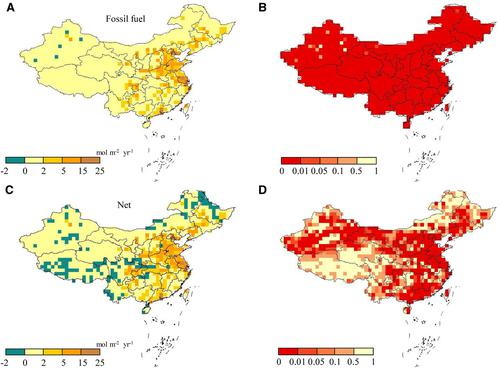当前位置:
X-MOL 学术
›
Ann. N. Y. Acad. Sci.
›
论文详情
Our official English website, www.x-mol.net, welcomes your
feedback! (Note: you will need to create a separate account there.)
Contribution of anthropogenic CO 2 in China to global radiative forcing and its offset by the ecosystem during 2000–2015
Annals of the New York Academy of Sciences ( IF 4.1 ) Pub Date : 2020-10-22 , DOI: 10.1111/nyas.14505 Nan Li 1, 2 , Yaoping Cui 1, 2 , Yiming Fu 2 , Xiaoyan Liu 2 , Yadi Run 2 , Mengdi Li 2 , Liangyu Chen 2 , Haoming Xia 1, 2 , Heli Lu 1, 2
Annals of the New York Academy of Sciences ( IF 4.1 ) Pub Date : 2020-10-22 , DOI: 10.1111/nyas.14505 Nan Li 1, 2 , Yaoping Cui 1, 2 , Yiming Fu 2 , Xiaoyan Liu 2 , Yadi Run 2 , Mengdi Li 2 , Liangyu Chen 2 , Haoming Xia 1, 2 , Heli Lu 1, 2
Affiliation

|
As the world's largest developing country, quantifying China's CO2 contribution to global warming is important for assessing the climate effects of anthropogenic and natural factors. We used global CO2 assimilation data from 2000 to 2015 and a carbon-climate parameterized scheme to analyze anthropogenic carbon emissions and their climatic effects while considering the climate effects of the terrestrial ecosystem carbon sink. Three results are notable: (1) From 2000 to 2015, global anthropogenic emissions increased from 2.48 to 3.45 mol m-2 , and net emission (sum of anthropogenic and natural emissions) rose from 1.24 to 2.51 mol m-2 ; China's contribution of anthropogenic emissions to global anthropogenic emission was 34.78% and to net emission 39.65%. (2) By 2015, radiative forcing (RF) caused by CO2 absorption in the global terrestrial ecosystem was -0.18 Wm-2 , and this offset accounts for 30.96% of the warming effect of global anthropogenic carbon emissions; in China, RF caused by the terrestrial ecosystem was -0.04 Wm-2 , and this offset accounts for 20.27% of the warming effect of China's anthropogenic carbon emissions. (3) Using CO2 assimilation data and sectoral inventory data, China's contribution of carbon emissions to global RF was 10.02% and 9.73%, respectively, and China's contribution of net RF to global RF was 7.93%. Our findings highlight the importance of ecosystems on mitigating climate warming.
更新日期:2020-10-22











































 京公网安备 11010802027423号
京公网安备 11010802027423号